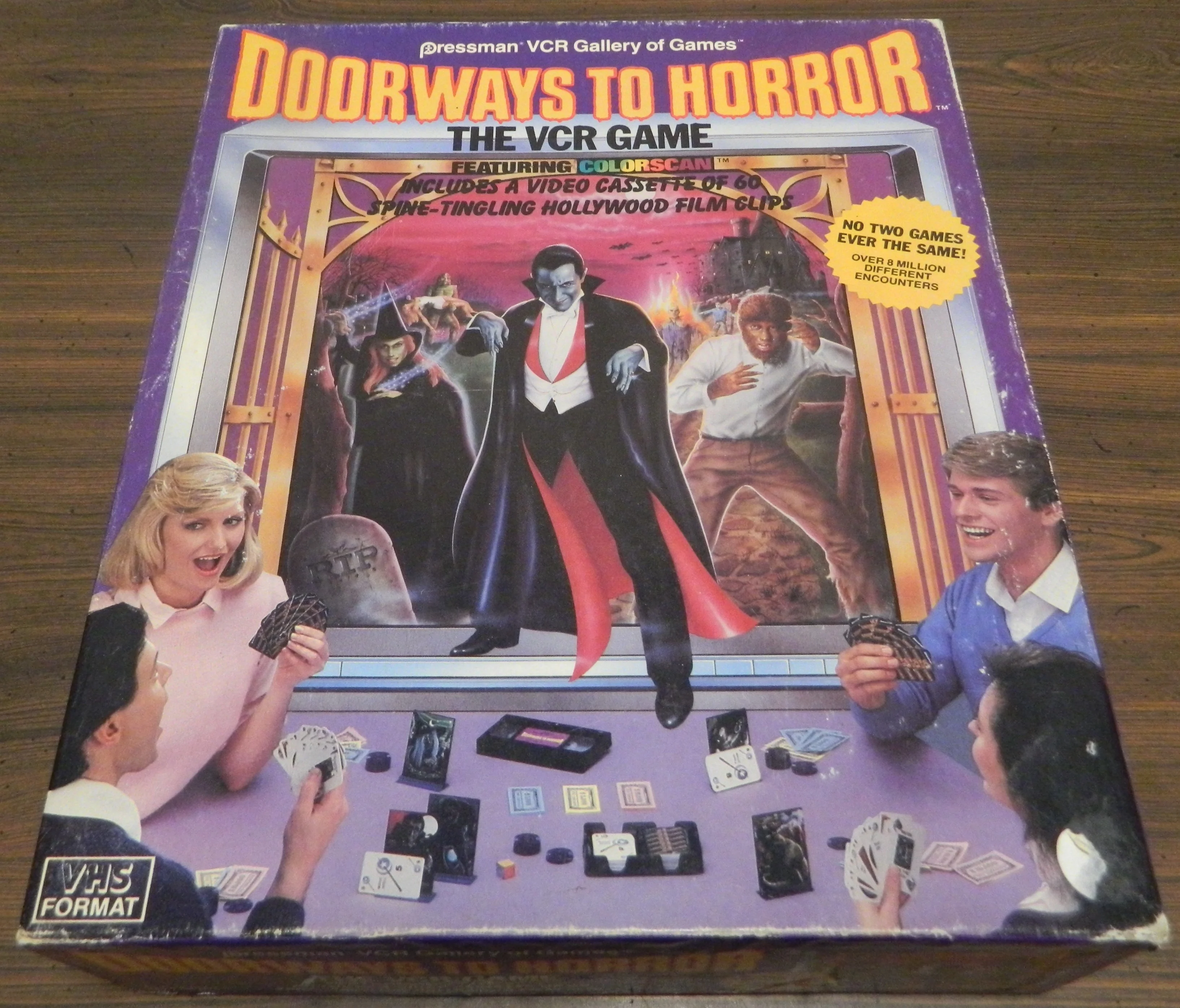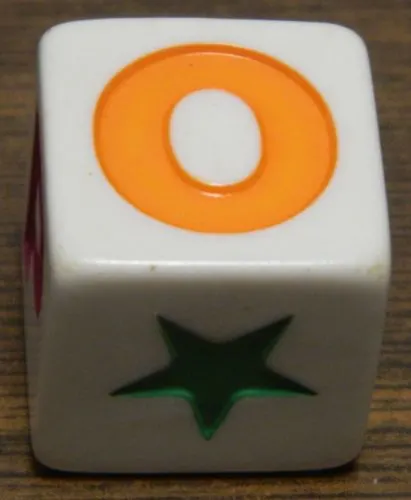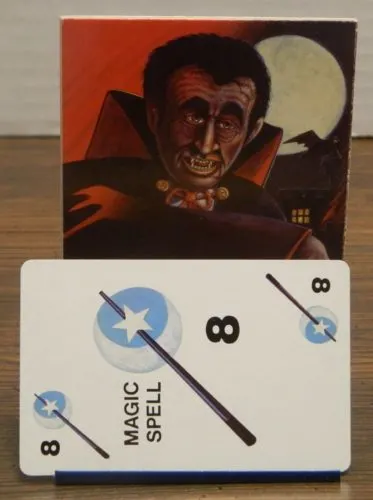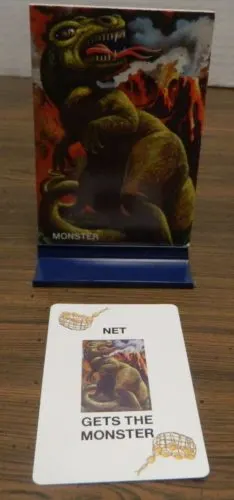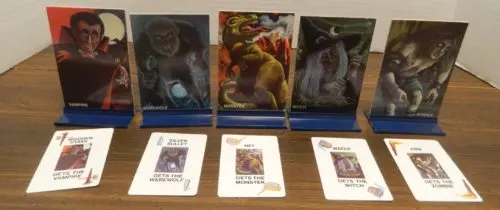Back in the 1980s there was a weird trend in board games where they started to add audio visual elements. With VCRs becoming more popular and widespread during the 1980s quite a few board game publishers decided to try to jump on the bandwagon and add a VHS component to their games. From the mid 1980s to the late 1990s around 60-70 different VHS board games were released. This ultimately lead to the introduction of DVD games which were popular for a while until they eventually died out in the early 2010s. While I have played quite a few DVD board games, I haven’t played many VHS board games. This is partially due to the fact that while games like Scene It? actually utilized the audio visual elements well, VHS games had to overcome quite a bit more because of the technical limitations. This lead to a lot of the VHS board games being pretty bad overall. Due to the Halloween season just wrapping up and the fact that Sid Sackson (one of the most well known board game designers of all time) having designed it, I decided to try out Doorways to Horror. Doorways to Horror was trying to be a scary board game utilizing the newest technology of the 1980s (the VCR) but unfortunately the scariest thing about Doorways to Horror is the game itself.
How to Play Doorways to Horror VCR Game
Setup
- Shuffle the cards and deal seven to each player. Place the rest of the cards face down in the card tray.
- Give each player strength chips as follows:
- 2 players – 20 chips
- 3 players – 15 chips
- 4 players – 12 chips
- 5 players – 11 chips
- 6 players – 10 chips
- Place the creature selection cards face down on the table. Players will take a number of cards based on the number of players:
- 2 players – 3 cards
- 3 players – 2 cards
- 4-5 players – Remove the “Touch Luck” card and then each player takes one card.
- 6 players – 1 card
- Each player will take the creature card(s) corresponding to the selection card(s) they drew and place them in front of themselves. Tough Luck does not correspond to any of the creatures. If there is a creature that is not claimed by any of the players it will sit in the middle of the table until someone captures it. The selection cards are then returned to the box.
- Insert the VHS tape into the VCR.
Playing the Game
Each round begins with one of the players rolling the die. Depending on what is rolled the next clip is selected.
- Y – Fast forward to the next clip that begins with a yellow door.
- O – Fast forward to the next clip that begins with a orange door.
- P – Fast forward to the next clip that begins with a purple door.
- B – Fast forward to the next clip that begins with a blue door.
- * – Play the clip behind the next door.
- ** – Skip one door and then play the clip behind the next door.
Casting Spells and Winning Gold
Once the clip starts playing the round begins. Each clip will feature one main creature (featured in the clip and referenced by the announcer) and two minor creatures (their pictures are shown on the screen). While the clip is playing players can do two things.
The first thing that a player can do is place spell cards on creatures. A player can only play spell cards on creatures that they currently control and can only play them on the main or minor creatures in the current clip. A player can only play one spell card to each creature card. The card is propped up on the stand against the creature card so the player who played it is the only person who can see it. Players want to play spell cards to creatures as these cards will reward gold to the player who controls the monster at the end of the clip. All spell cards must be played before the gong sounds in order to count.
The other thing that players can do while the clip is playing is steal creatures from other players. Only the main and minor creatures can be stolen during the round. In order to steal a creature you must play the appropriate capture card. All capture cards must be played before the sound of the gong in order to count. When a player steals a creature the spell card already played to it will stay with the creature when it moves to another player.
The creature/capture card combos are as follows:
- Werewolf – silver bullet
- Vampire – wooden stake
- Witch – water
- Monster – fire
- Zombie – net
When you reach the end of the clip you will pause the VHS tape to reward gold certificates from the bank. First the player(s) who control the minor creatures will receive gold certificates equal to the number on the spell card that was played to the creature. The player who controls the main creature will receive gold certificates equal to twice the value on the spell card that was played to it.
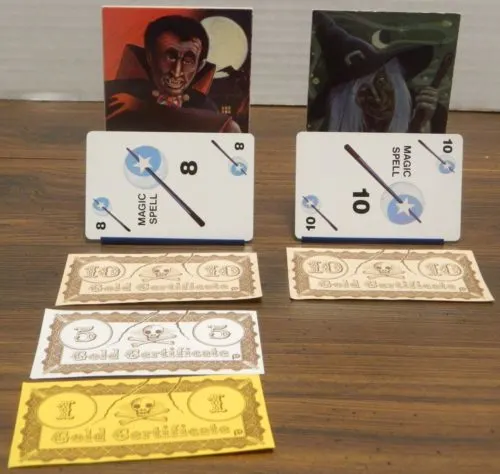
Here are two creatures that spell cards were placed on this round. The vampire was the main creature so the player will receive 16 gold certificates which is twice the magic spell card they played. Meanwhile the witch was a minor creature so the player will only receive ten gold certificates.
Bidding for the Main Creature
After players have received their gold certificates the players will bid for the main creature from the previous clip. All of the players can play one or two spell cards from their hand face down on the table. Once everyone has bid the player who bid the highest will take/keep control over the creature. If there is a tied bid the creature will stay with the player who currently controls it. The creature that was just bid on will be tipped down to indicate that it can’t be stolen during the next round.
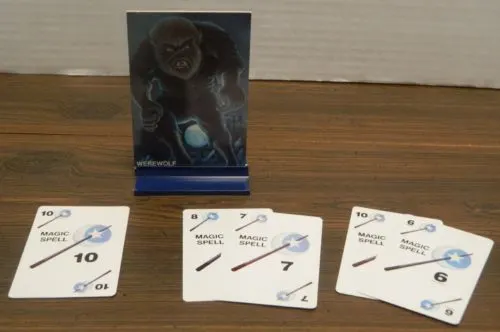
Three players have bid for the control of this creature. The player on the right has bid the most so they will take control of this creature.
After the bidding is concluded the players will determine who bid the least. The player who bid the least will lose a strength chip(s). If there is a tie all players tied for the lowest bid will lose a strength chip(s). At the start the lowest bidder(s) will lose one strength chip. This can be modified by special cards that can be played during the bidding phase. When a player plays one of these cards they must tell the other players that they have played one. Each player can only play one of these cards each round. The Loss of Strength card will add one chip to the amount of chips that the lowest bidder(s) will have to pay. The Protection card will reduce the number of chips that the lowest bidder(s) will have to pay by one. The total number of chips that the lowest bidder(s) will have to pay is equal to one plus whatever the combined effect of all of the special cards that are played. The total number of chips that players have to pay can never be reduced below zero though.
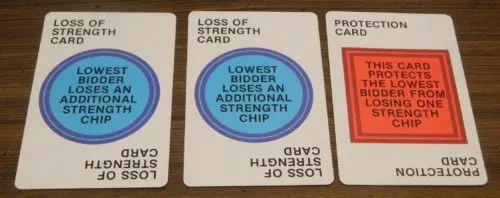
In this round players played two Loss of Strength cards and one Protection card. The lowest bidder(s) will lose two chips.
End of Round
At the end of the round the players will clean up from the previous round. All cards played during the round will be added to the discard pile. If you ever run out of cards in the draw pile you will shuffle the discard pile to create a new draw pile.
All of the players will then have the opportunity to draw up to four cards from the draw pile. There is no hand limit in the game.
Penalties
Throughout the game some penalty screens will appear behind some of the doors. When one of these come up the tape is paused while players read the penalty and carry out its effect. If two players are tied for the penalty it will be shared between the two players. If three or more players tie for the penalty, the penalty is cancelled. When a player has to pay gold certificates due to a penalty that they do not have, they will sacrifice one strength chip instead of the gold certificates.
End of Game
The game can end in one of two ways. If one or more players lose all of their strength chips the game ends immediately. The player(s) who lost all of their strength chips will automatically lose. The game otherwise ends when you reach the end of the tape. The player with the most gold certificates will win the game. If there is a tie the player who has the most strength chips remaining will win. If there is still a tie the player who controls the most creatures will win.
If you are playing a two player game there is one additional rule when determining the final winner. Each player will receive five gold certificates for each strength chip they have remaining at the end of the game. These gold certificates are added to their gold certificates acquired during the game to determine their final score.
My Thoughts on Doorways to Horror VCR Game
I have played over 700 different board games at this point and whether a game is good, bad, or completely average; I can usually get a good grasp on the game. Doorways to Horror may be one of only a few board games that left me dumbfounded after playing it and has me genuinely questioning why it was even made.
I didn’t have high expectations for Doorways to Horror as most VHS games were not very good. This was not always their fault as designers were trying to implement a new medium into board games and there were bound to be some growing pains. There were technical limitations inherit in VHS tapes as outside of fast forwarding there were no ways to skip to another scene. This meant that the games had to figure out a way to use a tape where you couldn’t quickly skip around. With the introduction of DVDs a lot of these issues were fixed as you could use different chapters to jump between scenes which gave you quite a few more options for what you could do with a game. With some time designers might have been able to come up with a good way to use the medium, but these VHS games were regularly rushed out the door to make a quick buck.
Normally I wouldn’t give Doorways to Horror much of a chance, but I held out some hope as it was designed by Sid Sackson. For those of you who are not familiar with Sid Sackson, he was a board game designer from the 1960s to 2002 when he passed away. Many of his game ideas are still being implemented into new games to this day. When many designers where making basic board games that no one remembers today, Sid Sackson was trying to bring the board game industry forward with new and creative board game mechanics. This lead him to create over 100 different board and card games during his life with quite a few being considered classics. It also lead to him being considered one of the earliest board game historians. He deserves a lot of credit for making the industry what it is today. With this pedigree I was hoping that Doorways to Horror would be at least a solid game. Unfortunately Doorways to Horror is one of the worst games that Sid Sackson ever created.
I say that Doorways to Horror is one of the worst games that Sid Sackson ever created because the game defies explanation. There are so many strange design choices that lead to a game that makes no sense. Basically Doorways to Horror is a game where a bunch of mechanics were taken from different genres and thrown together into a game. None of these mechanics really work well together leading to a convoluted mess. I don’t know how such a mess of a game was created by a well known designer who has a lot of great games to his name. I am generally curious if it was a case of Pressman consulting with Sid Sackson to design a VHS board game with little direction and a tight time frame.
If I had to describe the game I would basically break it down into three main mechanics. Lets begin with the VHS tape. The VHS tape for the most part is totally wasted as you don’t really even need it. It basically serves three purposes in the game. First it is supposed to add some entertainment to the game as you can watch some movie clips featuring various creatures. Well it turns out that the VHS tape basically consists of clips from public domain monster movies with some gameplay elements displayed on top of them in order to bring a purpose to the VHS tape. Second the VHS tape works as a timer. Players only have until the end of the clip to make whatever moves they want. Finally the VHS tape is used to choose which creatures are going to be the main and minor creatures for the current round. The biggest problem with the VHS is that it is totally pointless as you could have replaced its gameplay mechanics with a timer and some way of choosing the creatures for the round. As for watching the monster movie clips you are better off just watching a full monster movie instead of these short clips.
The next mechanic in Doorways to Horror involves what you do while the clip is playing. This consists of two intertwined mechanics. First you can play spell cards to one of the creatures shown in the clip. Second you can play cards to steal a creature from one of the other players. The game gives players the length of the clip to determine what cards if any they want to place on their own creatures and whether they want to try to steal one of the other players’ creatures. This mechanic doesn’t really work all that well as there is no reason to tip your hand until the last seconds. You don’t want to put a high value spell card on a creature until you know someone else won’t steal it. You also don’t want to try to steal a creature when the current owner hasn’t played a card on it and another player could just steal it from you with the play of a card. This leads to a lot of waiting around to see what the other players are going to do before taking an action of your own.
The final mechanic involves bidding for control over the main creature. This basically boils down to a pretty generic bidding mechanic. You need to suss out how much you think the other players will bid and determine how much you are willing to bid. Taking control of a creature gives you the ability to score points from it. Having control over a creature doesn’t mean much though as you are only guaranteed to keep it for one turn. I don’t really see the point in spending valuable spell cards to take a creature that another player could easily steal with the play of one card. The only somewhat interesting element of the bidding mechanic involves the strength chips. Normally there wouldn’t be a lot of reasons to bid high but whoever bids the least loses a strength chip. When you add in that players can play cards that force you to lose even more strength chips you might get into a situation where you have to try to win a bid just so you don’t lose your last strength chip and lose the game.
It shouldn’t come as much of a surprise that basically all of these mechanics rely on luck. Outside of gaining a small benefit from being able to read the other players, there really isn’t much strategy in Doorways to Horror. Most of the decisions in the game are quite obvious since if you know you will control one of the creatures you might as well play as high of spell card on it as possible so you receive more gold. The only decision that really makes a significant difference on the game is when you choose to use a capture card as the timing can be pretty important to maximize your score. Otherwise the game relies entirely on luck. Whoever controls the most creatures at the right times will have a huge advantage in the game. In addition the player that gets dealt the most high value spell cards as well as capture cards is going to have a very good chance of winning the game.
All of this leads to Doorways to Horror becoming a really boring game. The game takes a bunch of random mechanics and combines them into a game that feels like a random mess. None of the mechanics really work that well together and are better off by themselves. If they weren’t all blended together they could have been developed more and maybe turned into a better game. Together though they are all just really boring. I generally like to give games the benefit of the doubt by finishing at least one game, but I couldn’t do that with Doorways to Horror. The game was just too dull where I couldn’t stand playing the game for the full hour that it usually takes to complete.
Not surprisingly the components are not any better than the gameplay. As I mentioned earlier the VHS tape basically consists of small clips from public domain monster movies. On top of this there is a narrator that says some cheesy dialog while also naming the main creature. Otherwise towards the end of each clip two images of the minor creatures are displayed over the video. All of this looks pretty cheaply made where it doesn’t feel like a lot of effort was put into the components. The artwork ranges from average to pretty bad. Otherwise the components are pretty generic. The components serve their purpose but don’t do much else.
Should You Buy Doorways to Horror VCR Game?
Normally I don’t have high expectations for VHS games due to technical limitations and the fact that the medium was rarely used well. I had some hope though because the game was designed by Sid Sackson. Unfortunately Doorways to Horror is a bad game. I honestly have no idea why the game was even made. The game is basically a hodgepodge of random mechanics that don’t work well together. The VHS is pointless for the most part as it doesn’t bring anything to the game that couldn’t have been easily replaced with other components. Placing spell cards on creatures and stealing creatures boils down to a waiting game to see what the other players do. The bidding mechanics are really generic. All these mechanics are quite boring which is further reinforced by the fact that the game relies almost exclusively on luck. On top of all of this the components aren’t particularly good.
Ultimately I have a hard time recommending Doorways to Horror as it is a bad game. If you are a big fan of old monster movies or really like VHS board games, I could see you maybe getting a little enjoyment out of Doorways to Horror. Otherwise I would recommend avoiding it as it is a waste of time.

